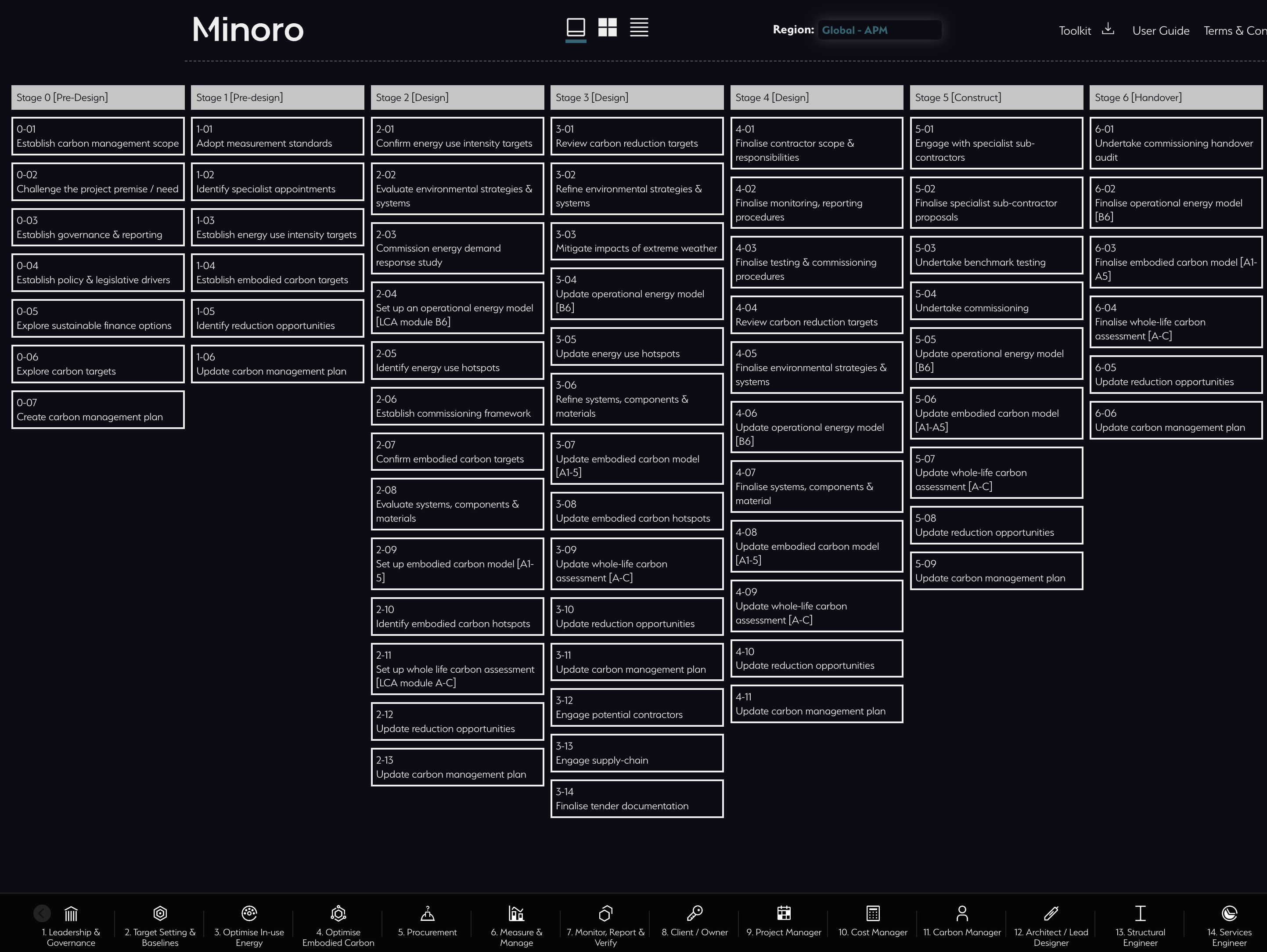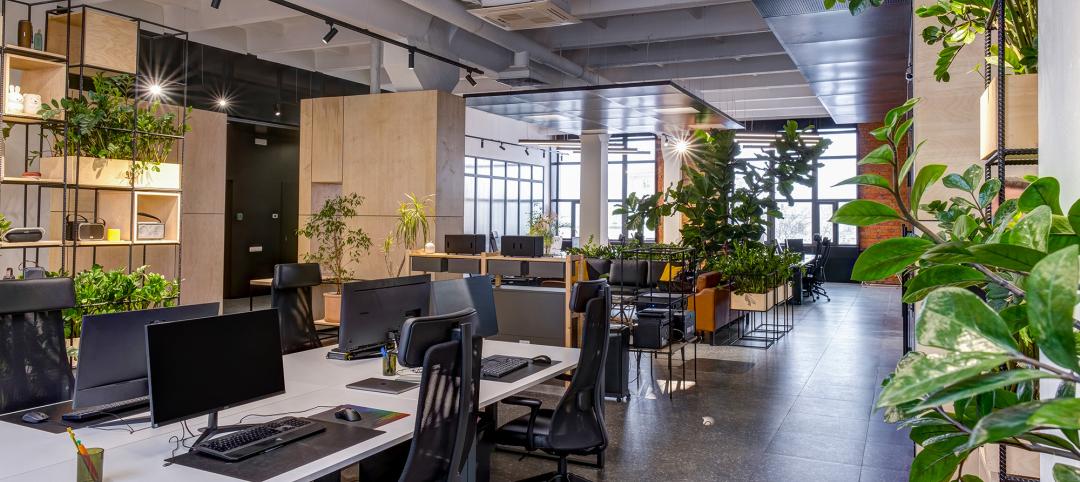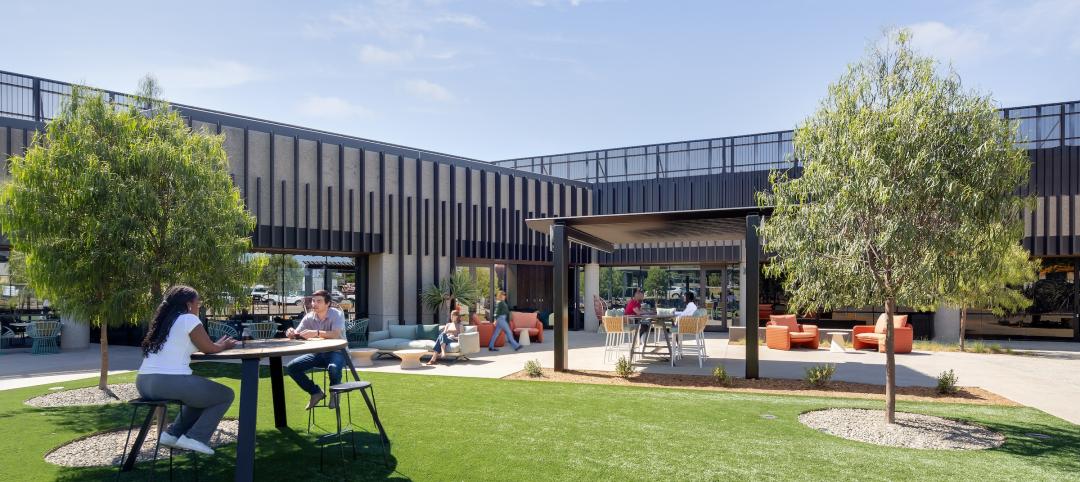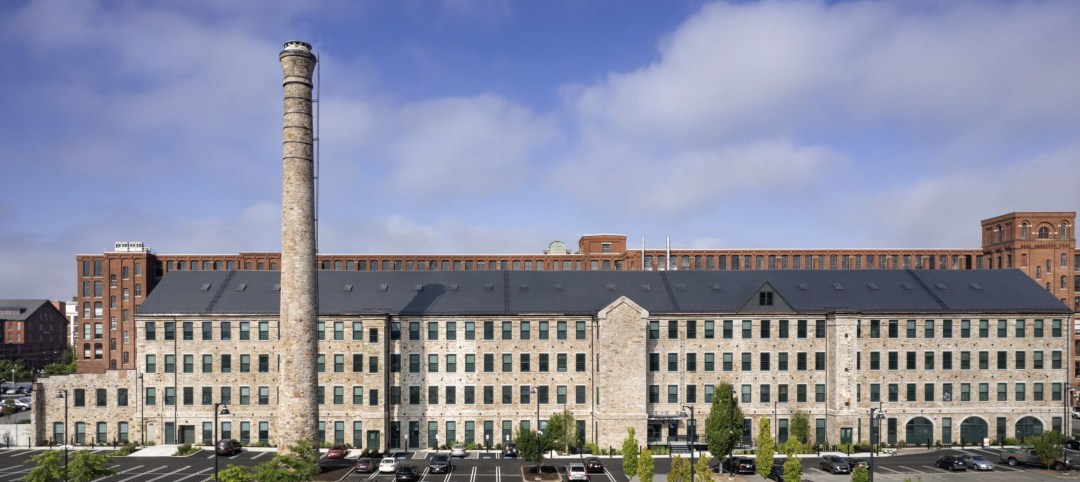Minoro, an online platform to help accelerate the decarbonization of buildings, was recently launched by architecture firm Grimshaw, in collaboration with more than 20 supporting organizations including World Business Council for Sustainable Development (WBCSD), RIBA, Architecture 2030, the World Green Building Council (WorldGBC) and several national Green Building Councils from across the globe.
The platform—minoro.org—hosts the latest guidance, methodologies, and policies on carbon management, linking the resources to a series of actions that can decarbonize new and existing buildings. This is the first time this information has been collated and centralized, according to a news release.
Free to use, the platform hosts global information and specific guidance supporting key regions including the U.K., Europe, U.S. and Canada, Australia and New Zealand. Information hosted on the platform has been contributed and reviewed by peers and organizations and will continue to be updated and informed with the latest information with more countries and regions planned to be included.
The tool can filter information from concept to operation, through specific actions or targets such as embodied carbon or procurement, or by responsibility from a client to supplier. The platform enables asset owners, investors, design teams, consultants, contractors and building operators to set targets and develop clear informed actions across every stage of a building life cycle. Responsibilities, and opportunities to reduce carbon emissions and meet targets and ambitions can be clearly identified.
Here is the full press release on the launch of Minoro:
Minoro, a new online platform designed to help accelerate the decarbonisation of buildings has been launched. Developed by Grimshaw in collaboration with over 20 supporting organisations including World Business Council for Sustainable Development (WBCSD), RIBA, Architecture 2030, the World Green Building Council (WorldGBC) and several national Green Building Councils from across the globe, Minoro – minoro.org – hosts the latest guidance, methodologies, and policies on carbon management, linking the resources to a series of actions that will decarbonise new and existing buildings.
An international resource Minoro provides links and access to over 1000 policies, guidance and methodologies, the first time this information has been collated and centralised. With the ability to filter information - from concept to operation, through specific actions or targets such as embodied carbon or procurement, or responsibility from a client to supplier - the platform enables asset owners, investors, design teams, consultants, contractors and building operators, to set targets and develop clear informed actions across every stage of a building life cycle. Responsibilities, and opportunities to reduce carbon emissions and meet targets and ambitions can be clearly identified and actioned.
Free to use, the platform currently hosts global information and specific guidance supporting key regions including the UK, Europe, US and Canada, Australia and New Zealand. Information hosted on the platform has been contributed and reviewed by peers and organisations and will continue to be updated and informed with the latest information with more countries and regions planned to be included.
“Developed over two years, Minoro not only brings, for the first time, all the key information to help tackle carbon in our buildings together in one place, but will also, importantly, bring teams together to work more effectively, aligning actions and maximising opportunities to avoid unnecessary carbon emissions in building projects,” said Paul Toyne, Sustainability Lead, Grimshaw.
“We know that buildings contribute almost 40% of the global energy related carbon emissions, but equally the route to decarbonising buildings is complex. The opportunity brought by Minoro is to help navigate this complexity and bring building owners and their project teams closer together in the setting of high ambitions and realising the incredible responsibility all stakeholders have to take effective action,” said Roland Hunziker Director, Built Environment, World Building Council for Sustainable Development.
"It's fantastic to see this project take off! Shaped by global expertise and bridging diverse disciplines within the built environment, Minoro is an impressive free resource for professionals across the value chain. It facilitates informed decisions to slash emissions and embodies the collaborative spirit of UKGBC, WorldGBC, and other GBCs. I hope Minoro will help our networks to drive forward climate action like never before!" said Smith Mordak, Chief Executive, UKGBC.
“Architects play a pivotal role in decarbonizing the built environment. Minoro, developed from the collective experience of stakeholders worldwide, supports both newcomers and seasoned professionals in collaborating through a common design and building process that builds on existing industry practice,” said Davina Rooney, CEO, Green Building Council Australia.
“Minoro comes a critical time for our industry. The access to guidelines and positive action, and the responsibility it identifies for all stakeholders in the project life cycle will serve to accelerate the change we need. Equally, the input and support of all the organisations behind its development is evidence of how vital collaborative action is,” said Andrew Whalley, OBE, Chairman, Grimshaw.
About Minoro
Minoro can be accessed via minoro,org. It has been developed over the past two years by Grimshaw and the WBCSD with the support of the WorldGBC. At its heart is the urgent action to address the decarbonisation of buildings, but also the responsibility, of all stakeholders in the built environment, to work collaboratively to turn targets into action. It supports the critical path of early-stage design and business case buy-in, the recognition of national and regional targets, and the implementation of innovation, design and financial incentives to surpass decarbonisation expectations.
A carbon management toolkit is also available on the platform to help users to track actions, identify opportunities and create a plan. Constantly reviewed and updated, feedback and contributions to Minoro platform can be provided through the feedback link on the website. It has been developed for and with the built environment industry and will continue to be managed as the most reliable platform for the latest policy, guidelines and methodologies to decarbonise buildings.
Related Stories
M/E/P Systems | Oct 30, 2024
After residential success, DOE will test heat pumps for cold climates in commercial sector
All eight manufacturers in the U.S. Department of Energy’s Residential Cold Climate Heat Pump Challenge completed rigorous product field testing to demonstrate energy efficiency and improved performance in cold weather.
MFPRO+ New Projects | Oct 30, 2024
Luxury waterfront tower in Brooklyn features East River and Manhattan skyline views
Leasing recently began for The Dupont, a 41-story luxury rental property along the Brooklyn, N.Y., waterfront. Located within the 22-acre Greenpoint Landing, where it overlooks the newly constructed Newtown Barge Park, the high-rise features East River and Manhattan skyline views along with 20,000 sf of indoor and outdoor communal space.
Resiliency | Oct 29, 2024
Climate change degrades buildings slowly but steadily
While natural disasters such as hurricanes and wildfires can destroy buildings in minutes, other factors exacerbated by climate change degrade buildings more slowly but still cause costly damage.
Hotel Facilities | Oct 29, 2024
Hotel construction pipeline surpasses 6,200 projects at Q3 2024
According to the U.S. Hotel Construction Pipeline Trend Report from Lodging Econometrics, the total hotel pipeline stands at 6,211 projects/722,821 rooms, a new all-time high for projects in the U.S.
Office Buildings | Oct 29, 2024
Editorial call for Office Building project case studies
BD+C editors are looking to feature a roundup of office building projects for 2024, including office-to-residential conversions. Deadline for submission: December 6, 2024.
Healthcare Facilities | Oct 28, 2024
New surgical tower is largest addition to UNC Health campus in Chapel Hill
Construction on UNC Health’s North Carolina Surgical Hospital, the largest addition to the Chapel Hill campus since it was built in 1952, was recently completed. The seven-story, 375,000-sf structure houses 26 operating rooms, four of which are hybrid size to accommodate additional equipment and technology for newly developed procedures.
Contractors | Oct 25, 2024
Construction industry CEOs kick off effort to prevent suicide among workers
A new construction industry CEO Advisory Council dedicated to addressing the issue of suicide in the construction industry recently took shape. The council will guide an industry-wide effort to develop solutions targeting the high rate of suicide among construction workers.
Sports and Recreational Facilities | Oct 24, 2024
Stadium renovation plans unveiled for Boston’s National Women’s Soccer League
A city-owned 75-year-old stadium in Boston’s historic Franklin Park will be renovated for a new National Women’s Soccer League team. The park, designed by Fredrick Law Olmsted in the 1880s, is the home of White Stadium, which was built in 1949 and has since fallen into disrepair.
Laboratories | Oct 23, 2024
From sterile to stimulating: The rise of community-centric life sciences campuses
To distinguish their life sciences campuses, developers are partnering with architectural and design firms to reimagine life sciences facilities as vibrant, welcoming destinations. By emphasizing four key elements—wellness, collaboration, biophilic design, and community integration—they are setting their properties apart.
Adaptive Reuse | Oct 22, 2024
Adaptive reuse project transforms 1840s-era mill building into rental housing
A recently opened multifamily property in Lawrence, Mass., is an adaptive reuse of an 1840s-era mill building. Stone Mill Lofts is one of the first all-electric mixed-income multifamily properties in Massachusetts. The all-electric building meets ambitious modern energy codes and stringent National Park Service historic preservation guidelines.

















